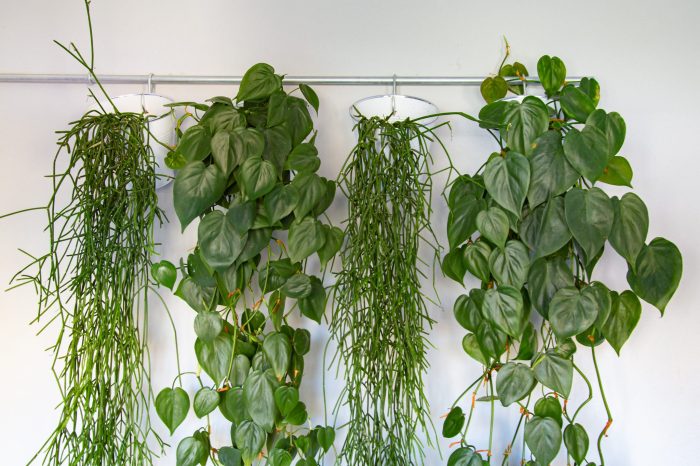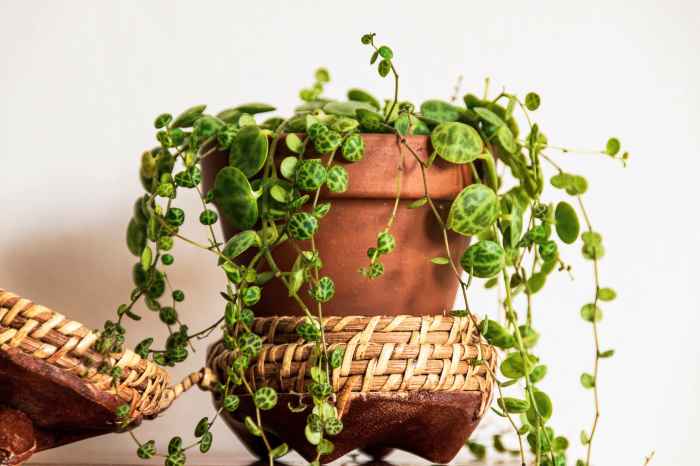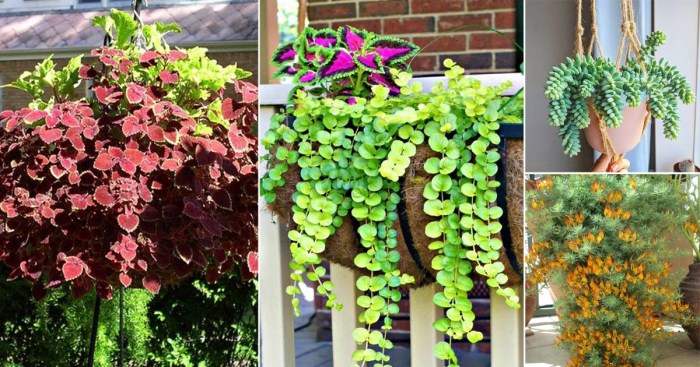Long trailing plants, with their captivating growth habits and diverse applications, have become a cherished element in the world of landscaping and interior design. Their cascading stems, adorned with lush foliage and vibrant blooms, add a touch of elegance and charm to any space.
From creating enchanting vertical gardens to adorning hanging baskets and providing lush groundcovers, long trailing plants offer endless possibilities for creative expression. Their ability to adapt to various growing conditions makes them ideal for both indoor and outdoor environments, enhancing aesthetics and functionality alike.
Plant Profiles
Long trailing plants are a popular choice for gardeners due to their versatility and ability to create a lush, cascading effect in gardens and containers. These plants are characterized by their long, flexible stems that can trail along the ground or be trained to climb trellises or other structures.
Trailing plants come in a wide variety of shapes, sizes, and colors, making them suitable for a wide range of gardening styles. Some popular trailing plants include:
- Creeping Jenny( Lysimachia nummularia): This low-growing perennial has small, round leaves and produces bright yellow flowers in the spring. It is a vigorous grower and can quickly cover a large area.
- Ivy( Hedera helix): Ivy is a classic trailing plant with glossy, evergreen leaves. It is a popular choice for groundcovers and can also be trained to climb walls or trellises.
- Vinca( Vinca minor): Vinca is a low-growing evergreen perennial with trailing stems and blue or purple flowers. It is a popular choice for groundcovers and can also be used in hanging baskets.
- Trailing lantana( Lantana montevidensis): This trailing shrub has clusters of small, brightly colored flowers that bloom throughout the summer. It is a popular choice for hanging baskets and containers.
- Sweet potato vine( Ipomoea batatas): Sweet potato vine is a fast-growing annual with heart-shaped leaves and trumpet-shaped flowers. It is a popular choice for groundcovers and can also be used in hanging baskets.
Trailing plants are generally easy to grow and require minimal care. They prefer well-drained soil and regular watering, but can tolerate some drought conditions. Most trailing plants do best in full sun to partial shade, but some, such as ivy, can tolerate full shade.
Landscaping Applications

Long trailing plants offer a plethora of opportunities to enhance the aesthetics and functionality of outdoor spaces. Their versatility allows for creative landscaping designs that cater to various needs and preferences.
These plants excel in creating vertical gardens, adding a touch of greenery to walls, fences, and trellises. Their cascading foliage drapes elegantly, creating a lush and eye-catching display. Hanging baskets adorned with long trailing plants add a touch of charm and color to balconies, patios, and porches.
Groundcovers
Long trailing plants are also ideal for creating dense groundcovers that suppress weeds and add a layer of visual interest to the landscape. Their ability to spread quickly and cover large areas makes them a practical choice for slopes, embankments, and areas with challenging growing conditions.
Incorporating into Existing Landscapes
Incorporating long trailing plants into existing landscapes is a strategic way to enhance aesthetics and functionality. They can be used to soften sharp edges, create privacy screens, or add a touch of elegance to walkways and patios. By carefully selecting species that complement the existing plants and design scheme, homeowners can create a cohesive and visually appealing outdoor space.
Long trailing plants can add a touch of elegance and greenery to any indoor space. To showcase these beautiful plants, consider using Amazon Plant Hangers Indoor . These stylish and functional hangers will elevate your greenery, creating a stunning display that will impress your guests.
Made from durable materials and designed to complement any décor, Amazon Plant Hangers Indoor are the perfect way to add a touch of nature to your home.
Propagation Techniques

Long trailing plants offer a unique and versatile addition to any garden, and propagating them is a rewarding way to expand your collection. Several methods can be employed to propagate these plants, including stem cuttings, division, and layering. Each technique has its own advantages and is suitable for specific plant varieties.
Stem Cuttings
Stem cuttings are a simple and effective way to propagate many long trailing plants. To take stem cuttings:
- Select a healthy stem with several nodes (the points where leaves attach).
- Using a sharp knife or pruning shears, cut a 4-6 inch section of stem just below a node.
- Remove the leaves from the bottom inch or two of the cutting.
- Dip the cut end of the stem in rooting hormone (optional but recommended).
- Plant the cutting in a well-draining potting mix and keep it moist.
- Place the cutting in a warm, bright location with indirect light.
- Roots will typically develop within a few weeks.
Division
Division is a method of propagation that is suitable for long trailing plants that form clumps or have rhizomes (underground stems). To divide a plant:
- Carefully dig up the plant and shake off the excess soil.
- Using a sharp knife or spade, divide the plant into smaller sections, each with its own roots.
- Replant the divisions in individual pots or in the garden.
- Water the divisions well and keep them in a shaded location until they have established themselves.
Layering
Layering is a propagation technique that involves encouraging a stem to root while still attached to the parent plant. To layer a plant:
- Select a long, flexible stem and make a shallow incision in the stem near a node.
- Pin the stem down to the soil with a wire or peg.
- Cover the incision with soil and keep it moist.
- Roots will develop at the incision, and the new plant can be severed from the parent plant once it has established its own root system.
The optimal time of year to propagate long trailing plants varies depending on the species and climate. However, most plants are best propagated in the spring or fall when temperatures are moderate and there is plenty of moisture available.
Plant Care and Maintenance
Long trailing plants are relatively easy to care for, but they do require some ongoing attention to maintain their health and appearance. Here are some general guidelines for caring for these plants:
Pruning, Long trailing plants
Regular pruning is essential for keeping long trailing plants in shape and preventing them from becoming leggy. Prune the stems back by about one-third to one-half their length in the spring or early summer. You can also prune the plants back more severely in the fall or winter, if necessary.
Long trailing plants are a popular choice for indoor gardening due to their ability to add a touch of greenery and life to any space. These plants are typically easy to care for and can thrive in a variety of conditions.
One of the most popular ways to display long trailing plants is by Hanging them from the ceiling or walls. This creates a dramatic effect and can help to save space. Long trailing plants can also be used to create a living wall or to add a touch of greenery to a balcony or patio.
Fertilizing
Fertilize long trailing plants every two to three weeks during the growing season with a balanced liquid fertilizer. Be sure to follow the instructions on the fertilizer label.
Pest Management
Long trailing plants are susceptible to a variety of pests, including aphids, mealybugs, and spider mites. Treat infestations promptly with an insecticidal soap or horticultural oil. You can also prevent pests by keeping the plants clean and free of debris.
Common Problems
Some common problems that may arise when growing long trailing plants include:
- Leggy growth:This can be caused by insufficient light or over-fertilization.
- Yellowing leaves:This can be caused by overwatering or nutrient deficiency.
- Brown tips on leaves:This can be caused by underwatering or low humidity.
By following these care tips, you can help your long trailing plants thrive and enjoy their beauty for many years to come.
Long trailing plants can add a touch of elegance and greenery to any indoor space. However, providing them with adequate light can be a challenge, especially in areas with limited natural light. For those looking to enhance the growth and appearance of their trailing plants, Wall Mounted Plant Grow Lights offer a convenient and effective solution.
These lights provide targeted illumination, promoting healthy growth and lush foliage. By incorporating Wall Mounted Plant Grow Lights into their indoor gardening setup, plant enthusiasts can enjoy the beauty of long trailing plants in even the most challenging lighting conditions.
Plant Design Ideas

Long trailing plants offer a unique opportunity to add drama and interest to any space. Their cascading foliage can create a sense of movement and flow, while their lush greenery can help to purify the air. There are many creative and inspiring ways to incorporate long trailing plants into your indoor and outdoor spaces.One
popular way to use long trailing plants is to create a living wall. This can be done by attaching plants to a trellis or other support structure. Living walls are a great way to add greenery to small spaces or to create a focal point in a larger room.Another
popular way to use long trailing plants is to create a hanging basket. Hanging baskets are a great way to add color and interest to patios, balconies, and other outdoor spaces. They can also be used to create a vertical garden on a wall or fence.When
choosing plants for your design, it is important to consider the size and shape of the space you have available. You should also consider the amount of light the space receives. Some long trailing plants, such as pothos and philodendron, can tolerate low light conditions.
Others, such as ivy and ferns, prefer brighter light.Once you have chosen your plants, you can start to create your design. Be creative and experiment with different combinations of plants and containers. You can also use other elements, such as rocks, wood, and metal, to add interest to your design.With
a little creativity, you can use long trailing plants to create beautiful and dynamic designs that will add life and interest to your home or garden.
Plant Combinations
When choosing plants for your design, it is important to consider the size, shape, and color of the plants. You should also consider the amount of light the space receives. Some long trailing plants, such as pothos and philodendron, can tolerate low light conditions.
Others, such as ivy and ferns, prefer brighter light.One popular way to create a visually appealing design is to use a variety of plants with different colors and textures. For example, you could pair a green pothos with a variegated philodendron and a trailing fern.
Another popular way to create a dynamic design is to use plants with different growth habits. For example, you could pair a cascading ivy with a trailing fern and a climbing philodendron.
Color Schemes
When choosing plants for your design, it is important to consider the color scheme of the space. You can use plants to create a monochromatic look, or you can use plants to add a pop of color to a neutral space.One
Long trailing plants, known for their cascading foliage, add a touch of elegance to any indoor space. To elevate their display, consider using Metal Hanging Planters for Indoor Spaces . These planters not only enhance aesthetics but also provide practical benefits, ensuring proper drainage and promoting healthy plant growth.
With their stylish designs and functional features, metal hanging planters are an ideal choice for showcasing long trailing plants and creating a captivating indoor oasis.
popular way to create a monochromatic look is to use plants with different shades of green. For example, you could pair a dark green pothos with a light green philodendron and a trailing fern. Another popular way to create a monochromatic look is to use plants with different textures.
For example, you could pair a smooth-leaved pothos with a fuzzy-leaved philodendron and a trailing fern.If you want to add a pop of color to a neutral space, you can use plants with brightly colored foliage. For example, you could pair a red-leaved philodendron with a green pothos and a trailing fern.
Another popular way to add a pop of color is to use plants with variegated foliage. For example, you could pair a variegated pothos with a green philodendron and a trailing fern.
Container Choices
When choosing containers for your long trailing plants, it is important to consider the size and shape of the plants. You should also consider the material of the container. Some popular materials for containers include ceramic, plastic, and metal.One popular way to create a visually appealing design is to use a variety of containers with different shapes and sizes.
For example, you could pair a large ceramic pot with a small plastic pot and a metal hanging basket. Another popular way to create a dynamic design is to use containers with different textures. For example, you could pair a smooth ceramic pot with a textured plastic pot and a metal hanging basket.
Final Review
Incorporating long trailing plants into your landscape or home decor not only adds visual interest but also provides numerous benefits. Their cascading growth habit helps purify the air, reduces noise pollution, and creates a sense of privacy. Whether you’re a seasoned gardener or a novice enthusiast, these versatile plants offer a rewarding and visually stunning way to transform your surroundings.
Answers to Common Questions: Long Trailing Plants
What are the ideal growing conditions for long trailing plants?
Most long trailing plants prefer well-drained soil, bright indirect light, and moderate watering.
How can I propagate long trailing plants?
Stem cuttings, division, and layering are common propagation methods for these plants.
What are some common problems associated with growing long trailing plants?
Overwatering, inadequate light, and pests are common challenges when growing long trailing plants.